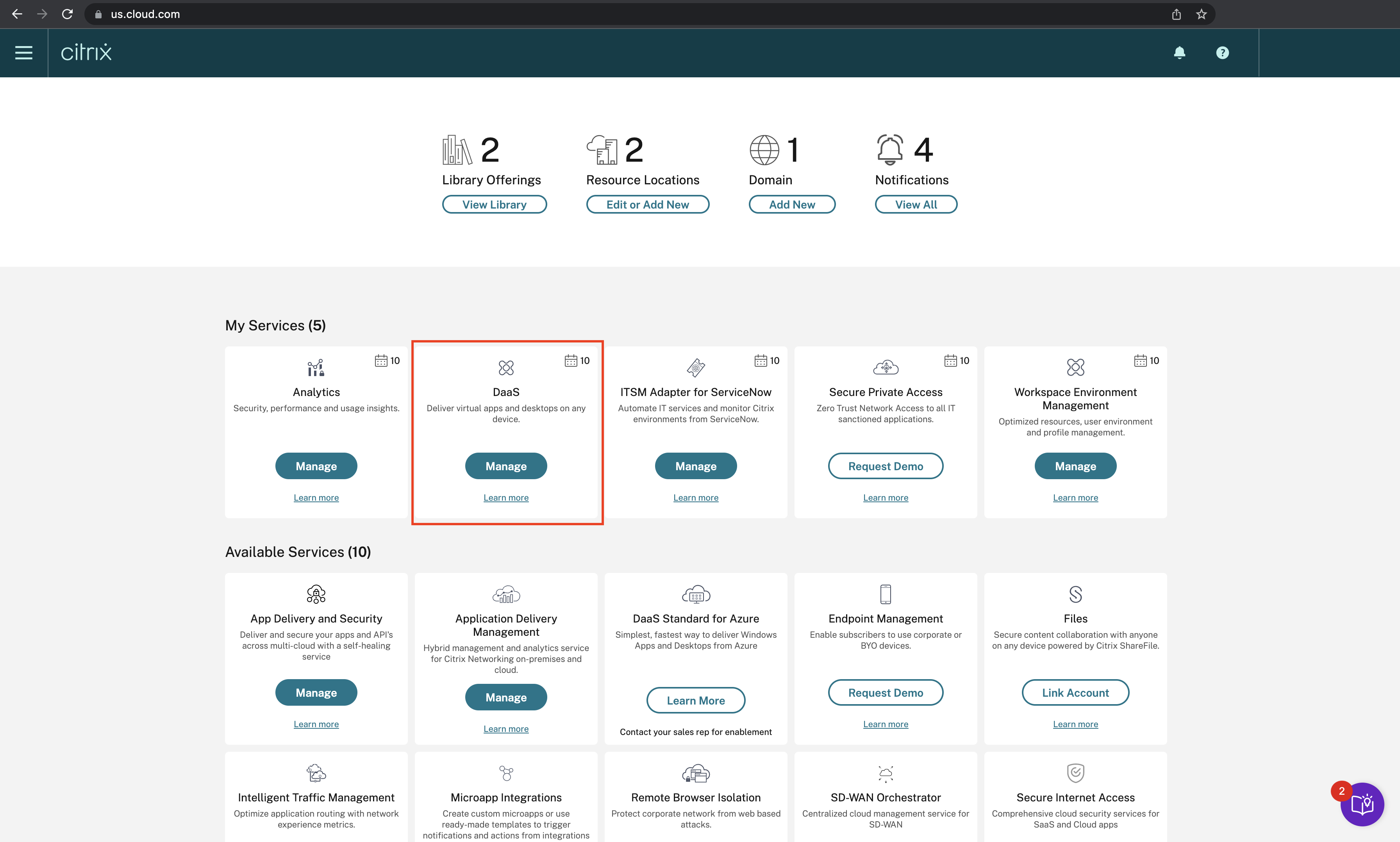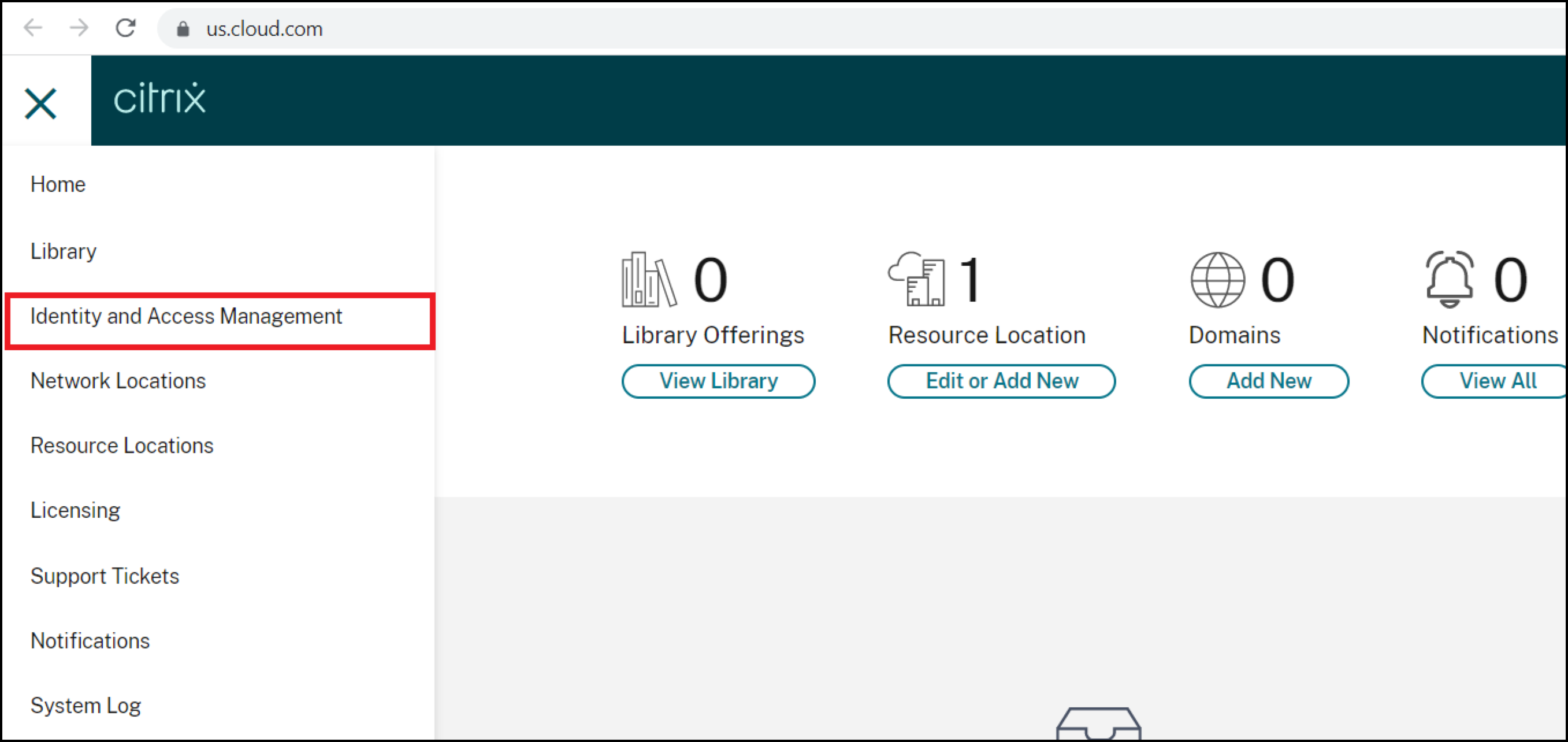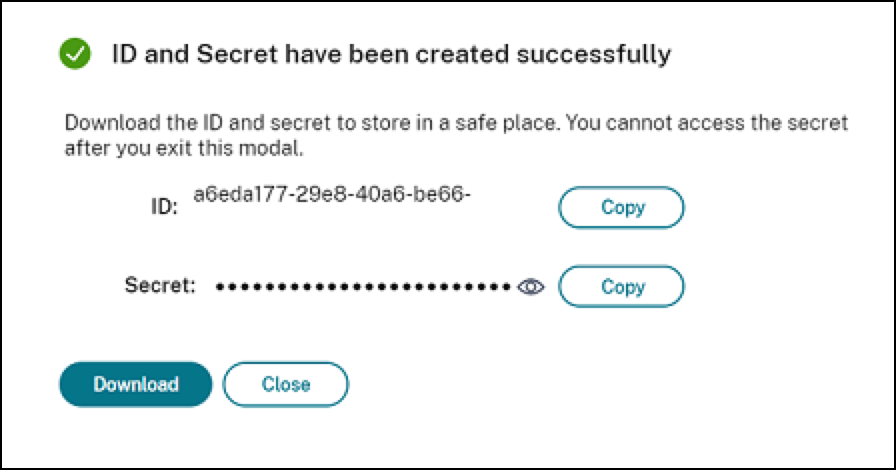Citrix Cloud Source
The Citrix Cloud source collects the system, operation, and session logs using the Citrix Cloud API and Citrix DaaS REST API to Sumo Logic. Citrix Cloud is a workspace management platform for IT administrators to design, deliver, and manage virtual desktops and applications, and other services, such as file sharing, on any device.
Data collected
| Polling Interval | Data |
|---|---|
| 5 min | System Log |
| 5 min | Item usage |
| 5 min | Config Operation Log |
| 5 min | Low-Level Operation Log |
| 5 min | Session Log |
Setup
Vendor configuration
Prerequisites
- The System logs are obtained using the Citrix Cloud API.
- To collect System logs from the Citrix Cloud platform, you must have an authorized Citrix Cloud account.
- Citrix Cloud APIs use an OAuth 2.0 authorization token to make authorized API calls.
- The Operation and Session logs are obtained using the Citrix DaaS REST API.
- To collect these logs, one needs to have a Citrix Cloud account with the DaaS Service enabled. Make sure this by signing in to the Citrix Cloud platform and checking the home page. Look for the presence of the DaaS service in the My Services section. If it is not listed, then you need to purchase this service to collect the Operation and Session Logs.

- To collect these logs, one needs to have a Citrix Cloud account with the DaaS Service enabled. Make sure this by signing in to the Citrix Cloud platform and checking the home page. Look for the presence of the DaaS service in the My Services section. If it is not listed, then you need to purchase this service to collect the Operation and Session Logs.
In this configuration, you will set up the Citrix Cloud source account and configure it to be authorized and authenticated to use system logs and alerts from Citrix Cloud API. To obtain the Citrix Cloud auth token, you will need the following parameters:
Base URL
The Base URL is the URL where your Citrix Cloud account is located. To get the base URL, follow the steps below:
- Log in to the Citrix Cloud application.
- At the top of the browser, you will see the Base URL inside the address bar.

- Choose the Base URL from the table below. The following table contains the base URLs based on the location of your Citrix Cloud account:
| Server location | Server located at | Base URLs |
|---|---|---|
| US Server | United States | https://api-us.cloud.com |
| APAC Server | Asia Pacific South | https://api-ap-s.cloud.com |
| EU Server | European Union | https://api-eu.cloud.com |
| JP Server | Japan | https://api.citrixcloud.jp |
API client
The API security token is used to authenticate with Citrix Cloud API. After successfully creating the API client, you will get the Client Id, Client Secret, and Customer Id. To get the Citrix Cloud API token, follow the steps below:
- From the Citrix Cloud Console, navigate to the
 menu icon.
menu icon. - Select the Identity and Access Management option from the menu.
 note
noteIf this option does not appear, you may not have adequate permissions to create an API client. Contact your administrator to get the required permissions.
- Select the API Access tab.

- Give a name to your Secure Client, and click Create Client.

- A dialogue box will appear notifying you that your Client ID and Secret key have been successfully created. You can download or copy and paste the Client Id and Secret key to a folder location because you will need them when creating the Citrix Cloud-to-Cloud Source.

- After closing the previous dialogue box, copy and paste the Customer Id, which is written straight above the Create Client button, into a folder. Look at the red highlighted box.

Source configuration
When you create a Citrix Cloud Source, you add it to a Hosted Collector. Before creating the Source, identify the Hosted Collector you want to use or create a new Hosted Collector. For instructions, see Configure a Hosted Collector.
To configure the Citrix Cloud API:
- New UI. In the Sumo Logic main menu select Data Management, and then under Data Collection select Collection. You can also click the Go To... menu at the top of the screen and select Collection.
Classic UI. In the main Sumo Logic menu, select Manage Data > Collection > Collection. - On the Collectors page, click Add Source next to a Hosted Collector.
- Search for and select Citrix Cloud.
- Enter a Name to display for the Source in the Sumo Logic web application. The description is optional.
- (Optional) For Source Category, enter any string to tag the output collected from the Source. Category metadata is stored in a searchable field called
_sourceCategory. - (Optional) Fields. Click the +Add Field link to define the fields you want to associate. Each field needs a name (key) and value.
 A green circle with a check mark is shown when the field exists and is enabled in the Fields table schema.
A green circle with a check mark is shown when the field exists and is enabled in the Fields table schema. An orange triangle with an exclamation point is shown when the field doesn't exist in the Fields table schema. In this case, you'll see an option to automatically add or enable the nonexistent fields to the Fields table schema. If a field is sent to Sumo Logic that does not exist in the Fields schema it is ignored, known as dropped.
An orange triangle with an exclamation point is shown when the field doesn't exist in the Fields table schema. In this case, you'll see an option to automatically add or enable the nonexistent fields to the Fields table schema. If a field is sent to Sumo Logic that does not exist in the Fields schema it is ignored, known as dropped.
- Base URL. Choose the URL where your Citrix Cloud account is located. See Base URL section to know your base URL.
- Customer ID. Enter the Customer ID you generated and secured from the API Client section in step 6.
- Client ID. Enter the Client ID you generated and secured from the API Client section in step 5.
- Client Secret. Authenticate your account by entering your Secret API key. Enter the Secret key you have generated and secured from API Client section in step 5.
- Supported APIs to Collect. Select any or all of the data sources such as System Logs, Operation Logs, Monitor Data Session Logs. By default, the System Logs data source will be selected.
- When you are finished configuring the Source, click Save.
Metadata fields
If the integration is configured with the SIEM forward option, set the Metadata field _siemparser to /Parsers/System/Citrix/Citrix Cloud C2C.
Session logs are not supported with the SIEM forward option.
JSON schema
Sources can be configured using UTF-8 encoded JSON files with the Collector Management API. See how to use JSON to configure Sources for details.
| Parameter | Type | Value | Required | Description |
|---|---|---|---|---|
| schemaRef | JSON Object | {"type":"Citrix Cloud"} | Yes | Define the specific schema type. |
| sourceType | String | "Universal" | Yes | Type of source. |
| config | JSON Object | Configuration object | Yes | Source type specific values. |
Configuration Object
| Parameter | Type | Required | Default | Description | Example |
|---|---|---|---|---|---|
| name | String | Yes | null | Type a desired name of the source. The name must be unique per Collector. This value is assigned to the metadata field _source. | "mySource" |
| description | String | No | null | Type a description of the source. | "Testing source" |
| category | String | No | null | Type a category of the source. This value is assigned to the metadata field _sourceCategory. See best practices for details. | "mySource/test" |
| fields | JSON Object | No | null | JSON map of key-value fields (metadata) to apply to the Collector or Source. Use the boolean field _siemForward to enable forwarding to SIEM. | {"_siemForward": false, "fieldA": "valueA"} |
| baseURL | String | Yes | null | Region URL of the Citrix Cloud application. | |
| customerID | String | Yes | null | Customer ID of the environment. | |
| clientID | String | Yes | null | Client ID for the API client. | |
| clientSecret | String | Yes | null | Client Secret for the API client. | |
| supportedAPI | Array | Yes | Select any of the given data sources or all the data sources, such as System Logs, Operation Logs, Monitor Data Session Logs. |
JSON example
loading...
Terraform example
loading...
Troubleshooting
This section provides information on how to troubleshoot failures while configuring our Citrix Cloud Source.
Authentication API error
Error message
{
"error": "invalid_client",
"error_description": "Invalid client id or client secret."
}
Solution
Make sure that you have used the correct baseURL, clientId, and clientSecret while configure the source.
System Logs API errors
Error message
{
"statusCode": 500,
"message": "Internal server error",
"activityId": "XXXXXX"
}
Solution
Make sure that you have used the correct baseURL is used to configure the source.
Error message
{
"type": "https://errors-api.cloud.com/common/authentication",
"detail":"Missing or invalid authentication details",
"parameters": [
{
"name":"reason","value": "invalid"
}
]
}
Solution
Make sure that you have used the correct customerId is used to configure the source.
SiteID, Operation Logs, and Low-Level Operation Logs API error
Error message
{
"statusCode": 500,
"message": "Internal server error",
"activityId": "XXXXXX"
}
Solution
- Make sure that you have used the correct
customerIdandbaseURLare used to configure the source. - Make sure that the provided
customerIdhas the DaaS Service enabled. Refer to the Prerequisites section.
Session Logs API error
Error message
Access denied to query Monitor objects : Invalid Customer.
Solution
- Make sure that the correct
customerIdandbaseURLare used to configure the source. - Make sure that the provided customerId has the DaaS Service enabled. Refer to the Prerequisites section.
FAQ
Click here for more information about Cloud-to-Cloud sources.